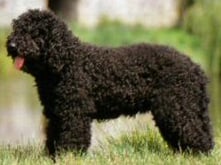The Barbet Dog is also referred to as French Water Dog, Barbette, griffon d’arret a poil laineux and French Gun Dog
About Barbet
Country of Origin, History of the breed
 Though the real origin of the Barbet is lost in antiquity yet it has been opined that France had been the country of origin of the dog. The Barbet has been perceived as the original water dog of Europe. It had been known since the Middle Ages. Its progenitors date to the fourteenth century. Again this dog has been the ancestor of various modern breeds and types like the Poodle, the griffons, the Newfoundland and French sheepdog of Brie region.
Though the real origin of the Barbet is lost in antiquity yet it has been opined that France had been the country of origin of the dog. The Barbet has been perceived as the original water dog of Europe. It had been known since the Middle Ages. Its progenitors date to the fourteenth century. Again this dog has been the ancestor of various modern breeds and types like the Poodle, the griffons, the Newfoundland and French sheepdog of Brie region.
Over the years Barbets had been employed for a variety of tasks. They had been used as a hunter’s assistant, as a shepherd dog for driving flocks and as a sailor’s companion helping out in securing lost items and lines at sea. The versatility of the breed and the multiple purposes to which they can be put has made the Barbets so very popular.
A General Description of the Breed
Barbets are medium sized and medium proportioned and have a characteristic thick, woolly coat covering their entire body. This coat is more curly than wavy. The coat provides efficient protection against damp and cold and forms a beard on the chin (‘barbe’ in French) that gives the dog its name- Barbet. The hairs on the head are especially long and cover up the eyes and the nose and form a mustache too (covering the bridge of the nose fully) alongside the beard. Their colors vary between black, chestnut, fawn, gray and white. However, it is uncommon to find mixed colors on the dog’s body. The dogs may or may not have any markings on their bodies.
Barbets have rounded and broad skulls and defined stops. They have square muzzles that are slightly shorter than the skulls. They have dark brown eyes and a black or brown nose. Their ears are long and broad and dropping. They have long tails whose ends form a slight hook.
Height
Male: 57 cm and 66 cm
Female: 52 cm and 62 cm.
Weight: 17 kg and 28 kg.
Personality
Temperament of the Breed
The Barbets have a passion for water. Their love for swimming/engaging in playful activities in water does not die down even if it is cold. They are friendly and joyful creatures that serve as good and efficient companions. Barbets can be easily trained and they adapt themselves well to different situations. Hunters find them capable retrievers particularly of waterfowl while shepherds find them an effective aide in driving flocks. Again, sailors perceive them as a great help in fetching lost items and lines at sea.
Better suited to outdoor or indoor lifestyle?
Barbets adjust well to just any home environment and do not create problems with children and dogs or other pets of the household. They take well to apartment life provided their owners arrange for long walks for them and arrange for their occasional indulgence in swimming or other water sporting activities. It is important that the owners and members of their families devote time for caring for their pet Barbets as these dogs always crave for attention and companionship.
Barbets make perfect pets and can adjust well in a household environment. The company of children or other dogs or other pets does not create any problems for them.
How active is the breed?
Since by origin Barbets are working dogs and enjoy water and retrieving tasks they need to be given such works regularly. This will provide them the exercising that they need. It is a good idea to take Barbet pets on long walks on a daily basis. Since swimming is a passion for such dogs they ought to be provided with opportunities for swimming as well.
Grooming
Maintenance of the wooly coat characteristic of the Barbet requires lot of efforts. The wooly coat gets matted easily particularly if the dog goes into water. This should be brushed and detangled with a comb with lots of care. The twigs, mattes, leaves etc. that may get stuck to the coat while the dog pursues its daily activities through bushes etc. can thus be removed.
In order to facilitate the proper growth of the coat and get a tighter curl it is advised to completely shave a puppy when it is between 4 months and 6 months of age. Even later on periodic shaving of the coat helps it to become thick.
Health and Care
Barbets are not high-strung outdoors and have been known to be having fewer health problems. However, in some bloodlines hip dysplasia, cataracts and skin allergies have been observed. These need to be checked out in case of puppies that are being purchased to be kept as pets.
for more info's like Here

No comments:
Post a Comment